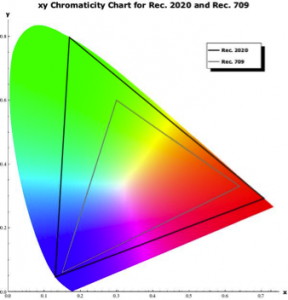Video
4K TVs: Grasping for Consumers

4K is a prominent buzzword in home entertainment and across the content industry. No doubt that during the Sochi Olympics, you will see an advertisement somewhere for UHDTV or 4K TVs, and you might even consider if the Olympics will look even better on your very own 4K TV. More and more 4K TVs are arriving at your local electronics store. In some cases, you might also hear it called UHDTV. In either case, this technology has been extensively researched and blogged about for the past few years, so what does it mean now? How do we separate hype from reality?
First, the 4K TV dam has been breached. Already we see many TV options appearing on electronics shelves with support for 4K, and we will see many more over the coming months and years. In fact, by next Christmas, you may just find the “old” HD TVs on the clearance aisle towards the back of the store. So, why are TV manufacturers so interested in selling these new 4K TVs? Over the past 10 years, TV manufacturers have flooded the consumer marketplace with HDTVs. Most people have at least one HDTV of some size in their home. With the market flooded, consumers only start moving into a cycle of buying a new TV when their current one fails (every 5 – 8 years). Of course, TV manufacturers are looking to sustain their revenues and profits. This means they look for compelling reasons for consumers to accelerate their purchasing cycle: enter 4K. Unfortunately, 4K has not proved to be quite as exciting as we all hoped it would be. Here are a couple of issues: First, consumers really can’t see the benefits of 4K due to screen size and viewing distances in most consumers’ living rooms. The issue involves our ability to perceive detail as we move away from any object. A simple example of this is to move up close to a lightly textured wall. Up close you can see every dimple and bump on the wall. Now move back 10 feet and see how many of those bumps and dimples you can identify. With this in mind, consumers have two options: 1) buy a really big screen (120” or more); or 2) move their sofa within 5 or 6 feet of their 65” TV. As you can see from the viewing distance chart, with a 65” TV you will have to sit right around 6 feet away to see the benefit of the 4K resolution.
(click on graphic for enlarged presentation)
Graphic Credit: Carlton Bale
Second, content providers aren’t really prepared to deliver 4K content to these new TVs, and some are several years away from providing any broadcast 4K. Sure there are rumblings of 4K from providers, but this content will be mostly limited to movie or trial content. Very few providers are adequately prepared to deliver a broad range of 4K broadcast content anytime soon, and they’re really debating the potential value. If consumers can’t see the value of it, why broadcast it?
So, where do we go from here? Are 4K TVs doomed, or just another passing fad like 3D TVs? There is some good news for 4K. Due to the fact it really isn’t much more expensive to build a 4K TV than an HDTV (<$300 extra), consumers don’t need to see as compelling a difference as would be required for a much higher premium. Many can be expected to pay the more modest premium with an expectation of “future proofing” their TV. This will motivate manufacturers to continue shifting their production in favor of 4K; ultimately 4K volumes will exceed HDTV volumes so that scale economies favor 4K and the perceived premium will shrink and eventually disappear. In addition to lower cost, as we saw at this year’s Consumer Electronics Show (CES), TV manufacturers recognized 4K resolution alone wasn’t going to cut it. With this in mind, they are introducing new video factors to improve the consumer experience. These new video factors include 10-bit versus 8-bit color depth. The benefits of this technology will create smoother transitions between colors as demonstrated in the following graphic:
Graphic Credit: Metus Ingest
In addition, cable operators are working with content providers to deliver higher frame rates to consumers, which will improve the overall smoothness of content, especially sporting events. They are also considering ways to improve dynamic range, which allows scenes to have a greater difference between bright content and dark content (e.g., sunlight and shadows). An example solution is Dolby Vision developed by Dolby for enhancing dynamic range as indicated in their graphic provided below:
(Dolby and the double-D symbol are registered trademarks of Dolby Laboratories.)
In addition to dynamic range, content providers and TV manufacturers are evaluating larger color spaces. A color space defines the number and shades of colors available for producing and displaying content. For a long time the industry has used the ITU REC.709 defined color space, which is less than our eyes can actually perceive. This was necessary in part due to TV technology at the time of its creation. Since then, TV technology has improved dramatically, and it is capable of displaying more colors. This has been recently marketed as wide color gamut. The industry is considering how to produce content and display it in more colors with the introduction of the ITU Rec.2020 specification, which greatly increases the number of colors as indicated in the following chart.
All of these features will most likely become available on new 4K TVs, so combined with an increase in resolution, these will provide a very compelling consumer experience. At CES, we saw many TV manufacturers already demonstrating variations of the technological advancements, and the cable industry has already been working with the entertainment industry to ensure they are adequately prepared to deliver content to take advantage of these advancements.
UHDTV is about to become more exciting, and it really has nothing to do with 4K.
Daryl Malas has been with CableLabs for over 6 years. As a Principal Architect in the Video Application Technologies group, he is leading research on 4K (UHDTV) for CableLabs. In addition, he has led other projects related to advanced video technologies, Content Delivery Networks (CDNs) and handling blackouts and advertisements within IP video delivery.





